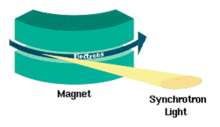Cyclotron radiation is radiation emitted by a charged particle being bent by a magnetic field. The only difference between cyclotron and synchrotron radiation is that the latter occurs at relativistic speeds. Is this right?
Now, AFAIK, synchrotron radiation is artificially produced by channeling the accelerated particle beam (I guess this would generally be electrons, but I suppose it could be protons like in the LHC) into an "insertion device." I know that wigglers and undulators are both examples, but I'm unclear on what exactly the difference between those two is.
What I don't get is what is done in a free-electron laser that differentiates it from a regular old synchrotron radiation source. Apparently synchrotron radiation is coherent, so it clearly is not that. Moreover, I'm confused where the stimulated emission comes into play. According to wikipedia, a free-electron laser uses free electrons (thus the name) instead of, for example, chromium doped sapphire a.k.a. ruby, as the gain medium. Except, hold on. . .the electrons certainly aren't static, they're moving, quite rapidly, so how would the photons reflect back to stimulate emission if the electrons are still moving forward right past them?
Am I correct in my assumptions, or am I totally wrong to begin with? Unfortunately, wikipedia is rather vague on the subject. I have tried to do some research on the subject, but I have found very little on the actual construction of a free-electron laser (at least, that wasn't behind a paywall). Thanks for your help!


